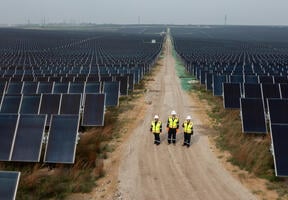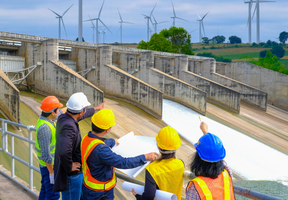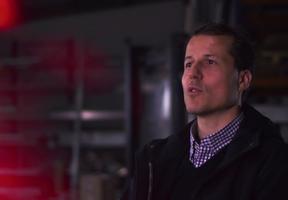Factsheet: Energy in Germany
10 min read
Germany is facing many energy challenges. It is in the course of the transition toward renewable energies, but is still highly dependent on fossil energies, and nonetheless aiming for carbon neutrality by 2045. This factsheet on energy in Germany presents explanatory tables to help understand the German energy system, its development and objectives. It can be used for a wide range of educational topics to prepare lessons on Germany in subjects such as history, geography, economic and social science, engineering science and modern languages.
A Bit of History 🧑🏫
The Rise of Industrial Power
As from the 19th Century, was the driving force behind the rise of the powerful German industry. In 2022 coal, and more specifically , was still the main energy source for generation.
Nuclear Energy, a Hot Debate
got off to a flying start in the 1970s, with a cooperation between French and German companies. In 2002, the socialists and ecologists imposed a Nuclear Exit Law, which was opposed by Chancellor Angela Merkel’s Christian-Democrats in 2010. But in March 2011, three days after the Fukushima disaster, Mrs. Merkel finally decided to pursue the phasing-out of nuclear energy. A decision that took effect in April 2023.
The 21st Century and the Dawn of Renewable Energies
From the year 2000, the German government (socialists and ecologists) decided on the mass development of renewable energies. Since then, wind and solar power have continued to develop strongly, despite the difficulties experienced by national industries in manufacturing photovoltaic cells, faced with competition from China.
The Basics 💡
The Energy Mix
The energy mix describes the distribution of the different sources used for domestic energy consumption in a given country.
This table shows the consumption of primary energies in Germany in 2023, expressed as a percentage.
Sources | 2023 |
Coal | 16% |
Oil | 35% |
Natural gas | 24% |
Nuclear | 0.5% |
Hydro | 1.6% |
Other renewables | 23% |
Source: Statistical Review of World Energy 2024
Germany is still highly dependent on fossil energies. Before the Russian invasion of Ukraine, it depended heavily on gas from Russia.
Germany has a large amount of coal and lignite resources, and the country extensively uses this high-pollution energy source, which also generates high- CO2 emissions.
Who Consumes the Energy?
At the end of the chain, this table shows the share of final energy consumed by the different sectors in 2023.
Sectors | 2023 |
Transport | 26.5 % |
Residential | 29 % |
Industry | 28.3 % |
Service | 14.4 % |
Agriculture | 1.4 % |
Source: Statistical Review of World Energy 2024
The Electricity Mix
The power generation (or ) mix refers to the combination of the various types of energy sources used to generate electricity in a given geographic region.
This shows the percentage share of the different sources of electricity in 2023.
Sources | 2023 |
Coal | 25% |
Oil | 1% |
Natural gas | 15% |
Nuclear | 1.4% |
Hydro | 4% |
Wind | 28% |
Solar | 12% |
Other renewables | 14% |
Source: Statistical Review of World Energy 2024
Since the year 2000, Germany has significantly developed wind and photovoltaic power. It also produces high volumes of biogas, but its hydro energy sources are low.
Greenhouse Gases
Year | Emissions in millions of tons of CO2 equivalent |
2000 | 899 |
2010 | 800 |
2020 | 732 |
2021 | 760 |
2022 | 750 |
2023 | 674 |
Source: German Government Environmental Agency (UBA)
Germany reduced its greenhouse gas emissions by 10% between 2022 and 2023.
This achievement was made possible by the rapid advance of sources, in particular solar and wind power, and by governmental campaigns to promote .
The decrease in production of entire sectors of its major energy-consuming industries is also a reason for the decrease in emissions. After the invasion of Ukraine, the freeze on Russian gas imports considerably slowed down the activity for a while.
In 2021, emissions in Germany stood at 9.1 tons of CO2 equivalent per inhabitant (6.2 in France and 10.7 in Poland).
Future Outlook
- Germany is aiming for carbon neutrality by 2045.
- It is targeting a 65% decrease in greenhouse gas emissions by 2030 compared with 1990, then 88% by 2040.
- The government has even brought forward the deadline for shutting down coal-fired power stations, from 2038 to 2030. By 2030, the production of electricity is set to be generated by at least 80% of renewable energies.
- Those in favor of this highly ambitious target are banking on the continued development of solar and wind power and also on the development of hydrogen as an .
What was the share of coal in power generation in Germany in 2022?
Over 31%
When is Germany aiming to achieve carbon neutrality?
2045, i.e. 5 years before the date initially planned.
In geography (grades 7-9), this factsheet provides recent data on the
and
emissions in Germany, related to the topic of “Preventing
risks”.
The challenges of the German
(renewables development, coal being phased out, electrification).
In sciences (grades 7-9), the different sources of energy (fossil, nuclear, renewable) and their environmental impacts are covered, in relation to the theme of “Energy resources”.
In geography (grade 10), the case of Germany is used to study the challenges of the energy transition in a developing country, in relation to the question of “Why and how to develop the region?".
In engineering sciences (grade 11), renewable energies (wind, solar) and nuclear technologies developed in Germany can be analyzed as part of the curriculum.
- Ask students to create a diagram to summarize the energy mix in Germany using data from the factsheet, and ask them to think about the advantages and disadvantages of each energy source.
- Organize a debate in class on Germany’s energy objectives and the means for achieving them, based on the challenges described on the factsheet.
- Suggest an exercise to compare energy consumption in Germany and France, using the same factsheet "Energy in France” on the Planète Energies website.
- Make the link to Franco-German day and suggest ideas for activities and projects for schools.
- Mention the Franco-German school exchanges and partnerships that are an opportunity to explore these issues further.
- Compare the German education systems and energy curriculums with those in France.















